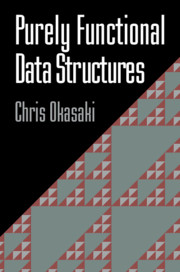Book contents
- Frontmatter
- Contents
- Preface
- 1 Introduction
- 2 Persistence
- 3 Some Familiar Data Structures in a Functional Setting
- 4 Lazy Evaluation
- 5 Fundamentals of Amortization
- 6 Amortization and Persistence via Lazy Evaluation
- 7 Eliminating Amortization
- 8 Lazy Rebuilding
- 9 Numerical Representations
- 10 Data-Structural Bootstrapping
- 11 Implicit Recursive Slowdown
- A Haskell Source Code
- Bibliography
- Index
7 - Eliminating Amortization
Published online by Cambridge University Press: 17 September 2009
- Frontmatter
- Contents
- Preface
- 1 Introduction
- 2 Persistence
- 3 Some Familiar Data Structures in a Functional Setting
- 4 Lazy Evaluation
- 5 Fundamentals of Amortization
- 6 Amortization and Persistence via Lazy Evaluation
- 7 Eliminating Amortization
- 8 Lazy Rebuilding
- 9 Numerical Representations
- 10 Data-Structural Bootstrapping
- 11 Implicit Recursive Slowdown
- A Haskell Source Code
- Bibliography
- Index
Summary
Most of the time, we do not care whether a data structure has amortized bounds or worst-case bounds; our primary criteria for choosing one data structure over another are overall efficiency and simplicity of implementation (and perhaps availability of source code). However, in some application areas, it is important to bound the running times of individual operations, rather than sequences of operations. In these situations, a worst-case data structure will often be preferable to an amortized data structure, even if the amortized data structure is simpler and faster overall. Raman [Ram92] identifies several such application areas, including
Real-time systems: In real-time systems, predictability is more important than raw speed [Sta88]. If an expensive operation causes the system to miss a hard deadline, it does not matter how many cheap operations finished well ahead of schedule.
Parallel systems: If one processor in a synchronous system executes an expensive operation while the other processors execute cheap operations, then the other processors may sit idle until the slow processor finishes.
Interactive systems: Interactive systems are similar to real-time systems ― users often value consistency more than raw speed [But83]. For instance, users might prefer 100 1-second response times to 99 0.25-second response times and 1 25-second response time, even though the latter scenario is twice as fast.
Information
- Type
- Chapter
- Information
- Purely Functional Data Structures , pp. 83 - 98Publisher: Cambridge University PressPrint publication year: 1998
